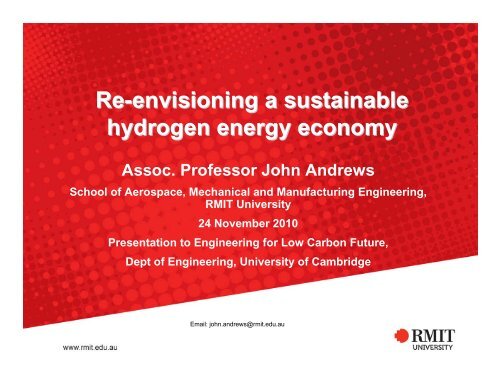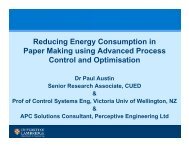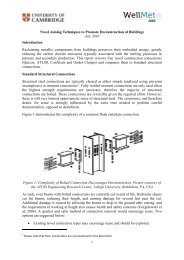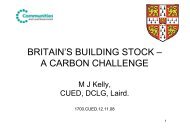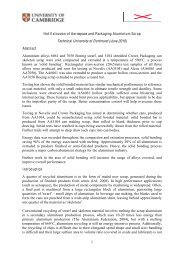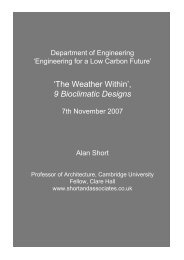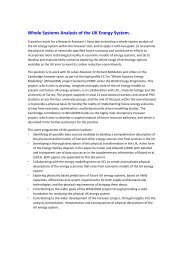Re-envisioning a sustainable hydrogen energy economy
Re-envisioning a sustainable hydrogen energy economy
Re-envisioning a sustainable hydrogen energy economy
Create successful ePaper yourself
Turn your PDF publications into a flip-book with our unique Google optimized e-Paper software.
<strong>Re</strong>-<strong>envisioning</strong> <strong>envisioning</strong> a <strong>sustainable</strong><br />
<strong>hydrogen</strong> <strong>energy</strong> <strong>economy</strong><br />
Assoc. Professor John Andrews<br />
School of Aerospace, Mechanical and Manufacturing Engineering,<br />
RMIT University<br />
24 November 2010<br />
Presentation to Engineering for Low Carbon Future,<br />
Dept of Engineering, University of Cambridge<br />
Email: john.andrews@rmit.edu.au
Topics for today<br />
• A new vision for a Sustainable Hydrogen Economy<br />
• The <strong>hydrogen</strong> skeptics, David MacKay and Steven Chu<br />
• Our work at RMIT University on <strong>Re</strong>newable Energy<br />
Hydrogen Systems<br />
• Questions and discussion
The <strong>hydrogen</strong> <strong>economy</strong> - origins<br />
“The phrase ‘A Hydrogen Economy’ arose for the first<br />
time in a discussion between Bockris and Triner of the<br />
General-Motors Technical Centre, 3 February<br />
1970.They had been discussing (along with others in a<br />
Group) the various fuels which could replace polluting<br />
gasoline in transportation and had come to the<br />
conclusion that <strong>hydrogen</strong> would be the eventual fuel for<br />
all types of transports. The discussion went to other<br />
applications of <strong>hydrogen</strong> in providing <strong>energy</strong> to<br />
households and industry, and it was suggested that we<br />
might live finally in what could be called ‘A Hydrogen<br />
Society’. The phrase ‘A Hydrogen Economy’ was then<br />
used later in the same conversation”.<br />
(Bockris 1975:18, Energy: The Solar Hydrogen Alternative)<br />
RMIT University©2010 SAMME 3
H2 <strong>economy</strong>
A solar-<strong>hydrogen</strong> system at the local scale:<br />
What about a solar-<strong>hydrogen</strong> houseboat on the Cam<br />
Energy services<br />
needed:<br />
• Motive power<br />
• Lighting<br />
• TV, radio,<br />
other electric<br />
appliances<br />
• Water heating<br />
• Space heating
Solar <strong>hydrogen</strong> Combined<br />
Heat and Power (CHP)<br />
System<br />
PV ARRAY<br />
Efficiencies:<br />
• PV array (13 – 20%, but CPV now<br />
30-40%)<br />
• PEM electrolyser (>90%)<br />
• Storage (pressurise with<br />
electrolyser, >95%)<br />
• PEM fuel cell (50 – 60%)<br />
• Elect-H2-elect roundtrip: ~50%<br />
• CHP system (in terms of use of H2<br />
<strong>energy</strong>): 70-80%<br />
Hydrogen<br />
Heat Exchanger<br />
Slide 6
500 W PEM fuel cell CHP experimental rig<br />
• Utilising the heat from the<br />
fuel cell as well the electricity<br />
can increase the cell’s<br />
overall <strong>energy</strong> efficiency from<br />
~30-55% for electricity<br />
generation only, to ~60-80%<br />
for heat and power<br />
generation<br />
See Shabani, Andrews and Watkins<br />
(2010); Shabani and Andrews (2011)
Solar-<strong>hydrogen</strong> system for a houseboat<br />
• Houseboat 19 m x 1.8 m, cover 25% area with PV panels<br />
• 1.3 kW peak PV capacity<br />
• Cambridge solar radiation 1050 kWh/m 2 /y<br />
• Assume 30% electricity demand met directly, 70% via H2 and fuel cell<br />
• Could then supply continuously just over 2 kWh/d throughout year<br />
• 3.2 kg H2 store needed. If current best metal hydride: mass 260 kg, vol 260 L<br />
• Use fuel cell heat for water heating. Would need other fuel for space heat<br />
• Enough electricity for frugal on-board living.<br />
• Would need more PV (or an aerogenerator) and larger H2 storage if H2 used<br />
for motive power via electric motor too.<br />
Slide 8
The original vision of a <strong>hydrogen</strong> <strong>economy</strong>:<br />
• Conceived at a time when the primary concern was running out of oil<br />
and natural gas (Limits to Growth type arguments)<br />
• Impact of rising levels of carbon dioxide in atmosphere on climate had<br />
been only dimly realised<br />
• Large-scale <strong>hydrogen</strong> production by electrolysis of fresh or sea water<br />
using large solar power stations located in hot remote parts of the<br />
world (most notably the desert regions of North Africa, Saudi Arabia,<br />
and Australia), or nuclear fission reactors.<br />
• Hydrogen transmitted to distant population centres by very long<br />
pipelines for consumption in all sectors of the <strong>economy</strong><br />
• (later) production of <strong>hydrogen</strong> from natural gas and coal too<br />
RMIT University©2010 SAMME 9
Drivers towards a H2E<br />
Source: NREL 2005
<strong>Re</strong>newable paths to <strong>hydrogen</strong><br />
>2000 K<br />
Source: NREL 2005
Where does <strong>hydrogen</strong> fit in a global <strong>sustainable</strong> <strong>energy</strong><br />
strategy<br />
ENERGY<br />
EFFICIENCY<br />
NUCLEAR<br />
POWER<br />
ELECTRICITY<br />
RENEWABLES<br />
HYDROGEN<br />
+<br />
C<br />
C<br />
S<br />
NATURAL<br />
GAS<br />
COAL
<strong>Re</strong>cent ‘<strong>sustainable</strong>’ <strong>energy</strong> scenario based on <strong>hydrogen</strong><br />
• HyWays, 2007, Roadmap EU <strong>Re</strong>search Project (Integrated Project)<br />
(http://www.hyways.de/index.htmls) (Figs below from Doll and Wietschel, 2008)<br />
Energy for H2 production:<br />
• Nuclear dominant (31%)<br />
• Natural gas (steam reforming) (26%)<br />
• Coal (integrated gasification combined cycle)<br />
(14%)<br />
• <strong>Re</strong>newables (27%)<br />
Nuclear (<br />
In max H2 scenario,<br />
transport emissions more<br />
than 60% lower than 2000<br />
levels by 2050
Costs of producing <strong>hydrogen</strong> from renewables<br />
• Solar PV – PEM electrolyser (Melbourne insolation)<br />
• PV 8000 US$/kW; Electrolyser 1500 US$/kWe: 22 US$/kg<br />
≡ 3.2 US$/L petrol (current petrol price in Australia US$1.2/L)<br />
• PV 2000 US$/kW; Electrolyser 1000 US$/kWe:<br />
≡ 7 m/s) – H2<br />
production cost should be lower than for PV
Studies are showing H2 for transport can<br />
play major role in reducing emissions and<br />
dependence on oil by 2050.<br />
But a major portion of the H2 required is<br />
assumed to be produced using nuclear<br />
power and to a lesser extent fossil fuels.<br />
Can we construct a Sustainable Hydrogen<br />
Economy on just <strong>energy</strong> efficiency plus<br />
renewables
Key differences between the original <strong>hydrogen</strong> <strong>economy</strong><br />
(HE) and the <strong>sustainable</strong> <strong>hydrogen</strong> <strong>economy</strong> (SHE)<br />
• SHE set firmly in the context of zero greenhouse gas emission <strong>economy</strong> in<br />
terms of both the production of <strong>hydrogen</strong> from renewables and consumption,<br />
rather than just response to depleting fossil fuels<br />
• SHE involves decentralised distributed production of <strong>hydrogen</strong> from a wide<br />
variety of renewables and feedstocks, rather than centralised production from<br />
mainly solar and wind <strong>energy</strong> (and possibly nuclear), and very long distance<br />
transmission of <strong>hydrogen</strong> via pipelines, as in HE<br />
• In SHE, <strong>hydrogen</strong> and electricity play complementary roles as <strong>energy</strong> vectors,<br />
and <strong>hydrogen</strong> and batteries complementary roles as <strong>energy</strong> stores, in the<br />
transport, industrial, commercial and residential sectors.<br />
• SHE focuses exclusively on renewables, coupled with an equally strong<br />
emphasis on <strong>energy</strong> efficiency and demand management<br />
• In ideal SHE form, no <strong>hydrogen</strong> from fossil fuels, whether steam reforming of<br />
natural gas, or integrated gasification combined cycle coal-conversion with<br />
carbon capture and storage<br />
RMIT University©2010 SAMME 16
Seven principles underlying the SHE vision:<br />
1. A hierarchy of <strong>sustainable</strong> <strong>hydrogen</strong> production, storage and distribution<br />
centres relying on local renewable <strong>energy</strong> sources<br />
2. Hydrogen production from a range of renewables and feedstocks, without<br />
dependence on nuclear fission power or carbon capture and storage<br />
3. Minimising the <strong>hydrogen</strong> pipeline distribution network by distributed<br />
production of <strong>hydrogen</strong>, and complementary use of <strong>hydrogen</strong> and electricity<br />
as <strong>energy</strong> vectors<br />
4. <strong>Re</strong>cognition of the complementary roles of <strong>hydrogen</strong> and battery storage<br />
across a range of transport vehicles and transport services<br />
5. Use of <strong>hydrogen</strong> for longer-duration <strong>energy</strong> storage on centralised grids<br />
relying extensively on renewable <strong>energy</strong> inputs<br />
6. Employment of bulk <strong>hydrogen</strong> storage as strategic <strong>energy</strong> reserve to<br />
guarantee national and global <strong>energy</strong> security in a world relying increasingly<br />
on renewable <strong>energy</strong><br />
7. Concentration of <strong>hydrogen</strong> refuelling for most transport modes at a relatively<br />
small number of strategic locations.<br />
RMIT University©2010 SAMME 17
1. Hierarchy of <strong>sustainable</strong> <strong>hydrogen</strong> centres relying on<br />
local renewables<br />
RMIT University©2010 SAMME 18
Sustainable <strong>hydrogen</strong> centre<br />
hierarchy diagram - Legend<br />
RMIT University©2010 SAMME 19
Coastal Hydrogen Centre (CHC)<br />
Coastal Hydrogen Centre (CHC)<br />
H 2<br />
Electrolyser<br />
Fuel Cell<br />
Power<br />
Station<br />
Vehicle<br />
Fuelling<br />
Stations<br />
LH2<br />
Plant<br />
Electricity<br />
Hydrogen<br />
RMIT University©2010 SAMME 20
Coastal Hydrogen Centre (CHC)<br />
• Similar to OHC but land based<br />
• Locate close to major cities and <strong>energy</strong>-intensive industrial areas<br />
• Could employ either sea water or fresh water electrolysis<br />
• Hydrogen from natural gas could supplement renewables supply in<br />
short term<br />
• Bulk storage of <strong>hydrogen</strong> gas underground in depleted natural gas or<br />
oil reservoirs, excavated rock caverns, solution-mined salt caverns, or<br />
aquifers (cf. Foh et al. (1979), Taylor et al. (1986); ICI Teeside, UK)<br />
• Local pipeline transmission of <strong>hydrogen</strong> to fuelling stations for<br />
transport applications – road, rail, sea and air<br />
• Hydrogen fed to fuel cell power stations for inputting electricity into<br />
main grid when primary renewables insufficient<br />
• Excess grid electricity fed to electrolysers to produce <strong>hydrogen</strong><br />
RMIT University©2010 SAMME 21
Inland Hydrogen Centre (CHC)<br />
Inland Hydrogen Centre (IHC)<br />
H 2<br />
Electrolyser<br />
Fuel Cell<br />
Power<br />
Station<br />
Vehicle<br />
Fuelling<br />
Stations<br />
LH2<br />
Plant<br />
Electricity<br />
Hydrogen<br />
RMIT University©2010 SAMME 22
Inland Hydrogen Centre (IHC)<br />
• Distributed throughout the populated regions of a country, particularly<br />
near major inland cities, regional towns and industrial facilities<br />
• Hydrogen produced from local solar and wind power by electrolysis of<br />
fresh water, by photolysis of fresh water (if proven viable), from<br />
regional biomass resources, or excess grid electricity<br />
• Hydrogen from natural gas could supplement renewables supply in<br />
short term<br />
• Medium-scale bulk storage in nearby <strong>hydrogen</strong> storage facilities<br />
• Hydrogen supplied via local distribution network to:<br />
– road and rail transport<br />
– medium-scale fuel-cell power plants to supply local back-up electricity to<br />
the centralised grid to ensure continuous supply with minimal transmission<br />
losses<br />
RMIT University©2010 SAMME 23
Complementary roles of <strong>hydrogen</strong> and battery storage<br />
across a range of transport vehicles and services<br />
• Hydrogen can provide long-term storage, without significant losses<br />
(just like fossil fuels)<br />
• Batteries have superior roundtrip <strong>energy</strong> efficiency (electricity to<br />
electricity) for shorter duration storage<br />
• Batteries allow <strong>energy</strong> recovery via regenerative braking<br />
• Hydrogen has superior gravimetric and volumetric <strong>energy</strong> densities<br />
and hence gives greater travel range<br />
• Only <strong>hydrogen</strong> likely to be suitable for medium and long-distance<br />
road, rail and sea transport<br />
• Liquid <strong>hydrogen</strong> most suitable non-petroleum substitute fuel for jet<br />
and other aircraft<br />
RMIT University©2010 SAMME 24
Hydrogen FC and battery systems: basic on-board<br />
components<br />
HYDROGEN<br />
IN<br />
H2 STORAGE<br />
H2<br />
FUEL CELL<br />
ELECTRICITY<br />
OUT<br />
O2 FROM<br />
AIR<br />
ELECTRICITY<br />
IN<br />
ELECTRICITY<br />
OUT<br />
BATTERY BANK
RMIT University©2010 SAMME 26
RMIT University©2010 SAMME 27
Storage material and system<br />
Gravimetric:<br />
• US DoE target 2015 for H storage material: 1.08, system 0.35 kWe/kg (3x)<br />
• MH achieved: material 0.47, system 0.25 kWe/kg (~2x)<br />
• CH achieved: material 0.65, system 0.29 kWe/kg (~2x)<br />
Volumetric:<br />
• US DoE target 2015 for H storage material: 0.79, system 0.31 kWe/L (~2.5x)<br />
• MH achieved: material 0.47, system 0.25 kWe/kg (just under 2x)<br />
• CH achieved: material 0.51, system 0.26 kWe/kg (~2x)<br />
• All these <strong>energy</strong> densities assume FC efficiency of 0.5<br />
RMIT University©2010 SAMME 28
Honda FCX Clarity <strong>hydrogen</strong> car<br />
•Honda and and Nissan planning commercial<br />
production of HFC cars by 2015<br />
•Toyota planning HFC car for $50 000 by 2015<br />
Source: http://world.honda.com/news/2008/4080702FCX-Clarity/ 2 July 2008<br />
RMIT University©2010 SAMME 29
Specifications of Honda FCX Clarity<br />
Power train<br />
Number of occupants 4<br />
Motor<br />
Fuel cell stack<br />
Max. output<br />
Max. torque<br />
Type<br />
Type<br />
Max. output<br />
100kW<br />
256N·m<br />
AC synchronous electric motor<br />
(permanent magnet)<br />
PEMFC<br />
(Proton Exchange Membrane Fuel Cell)<br />
100kW<br />
Lithium ion battery Voltage 288V<br />
Fuel<br />
Type<br />
Storage<br />
Tank capacity<br />
Dimensions (L × W × H)<br />
Vehicle weight<br />
Maximum speed<br />
Energy storage<br />
Compressed <strong>hydrogen</strong><br />
Pressurized <strong>hydrogen</strong> tank<br />
(35MPa)<br />
171 liters<br />
4,835 × 1,845 × 1,470mm<br />
1,635kg<br />
160km/ h<br />
Lithium ion battery<br />
Source: http://world.honda.com/news/2008/4080702FCX-Clarity/ 2 July 2008<br />
RMIT University©2010 SAMME 30
Towards <strong>sustainable</strong> transport<br />
Horses (and feed!) for courses!<br />
• Supportive mode shifts to achieve sustainability<br />
• Appropriate fuels and storage technology by transport service<br />
RMIT University©2010 SAMME 31
Transport service Sustainable transport shifts Technology Primary <strong>energy</strong> source<br />
Urban short trip (
Hydrogen for longer-duration <strong>energy</strong> storage on<br />
centralised grids relying extensively on renewables<br />
Main options:<br />
• Batteries<br />
• Supercapacitors<br />
• Thermal storage, particularly for night-time supply with solar-thermal power<br />
– good for short-term storage, not for longer term (weeks to six months)<br />
• Geothermal power stations<br />
– can supply continuous power but total resource limited and far from cities<br />
• Biomass<br />
– Useful but limited power from waste incineration and CHP<br />
• Large-scale grid covering vast geographical area with distributed renewables<br />
– complementarity over time of variable inputs reduces need for <strong>energy</strong><br />
storage<br />
– Still seasonal variation, long-distance power transmission<br />
– Some guaranteed <strong>energy</strong> supply still required<br />
HENCE SOME HYDROGEN STORAGE AND FC POWER INPUT NEEDED<br />
RMIT University©2010 SAMME 33
Seasonal variation in wind power<br />
Max 11 knots, min 8 knots<br />
Power proportional to v 3<br />
Max power is 2.6 x min power, so major seasonal variation<br />
Source: Bureau of Meteorology, UK<br />
RMIT University©2010 SAMME 34
Seasonal variation of wave power - UK<br />
Source: Graham Sinden, “Wave and tidal power: resource, grid and integration”, Environmental<br />
Change Institute, University of Oxford
Seasonal variation of wave power - Australia<br />
Source: J. Fry, 2010, Ocean waves, <strong>energy</strong> and the southern Australian coast, M Eng<br />
(Sustainable Energy) thesis (RMIT University, Melbourne)
Bulk <strong>hydrogen</strong> storage as strategic <strong>energy</strong> reserve to<br />
guarantee national and global <strong>energy</strong><br />
• Need for strategic <strong>energy</strong> reserve with 100% reliability to meet<br />
demand in periods of low availability of renewables, and during major<br />
breakdowns or catastrophes (such as volcanic eruptions, cyclones,<br />
bushfires, floods, or droughts, or wars or terrorist attacks)<br />
• Bulk <strong>hydrogen</strong> storages as integral parts of offshore, coastal and<br />
inland <strong>hydrogen</strong> centres can meet this need:<br />
– role akin to fossil fuels today, except that <strong>hydrogen</strong> can be<br />
regularly replenished using the earth’s renewable <strong>energy</strong> income<br />
RMIT University©2010 SAMME 37
The <strong>hydrogen</strong> skeptics 1:<br />
David McKay, Sustainable Energy without the Hot Air (2009)<br />
• “...<strong>hydrogen</strong> is a hyped-up bandwagon... Hydrogen is not a miraculous source<br />
of <strong>energy</strong>; it’s just an <strong>energy</strong> carrier, like a rechargeable battery. And it is a<br />
rather inefficient <strong>energy</strong> carrier, with a whole bunch of practical defects”<br />
• “where is the <strong>energy</strong> to come from to make the <strong>hydrogen</strong><br />
• “...converting <strong>energy</strong> to and from <strong>hydrogen</strong> can only be done inefficiently – at<br />
least with today’s technology”<br />
RMIT University©2010 SAMME 38
The H-skeptics 1: David McKay<br />
Counter arguments<br />
• Indeed <strong>hydrogen</strong> is an <strong>energy</strong> carrier, but with some unique advantages:<br />
– Higher gravimetric and volumetric <strong>energy</strong> densities than batteries allows<br />
vehicle ranges near to today’s petrol and diesel, with short recharge time<br />
– Fuel for long-distance trucks, jets, ships, trains (where too costly to<br />
electrify)<br />
– Can provide longterm seasonal storage on grids in distributed manner at<br />
roundtrip efficiencies of ~50%, and strategic bulk <strong>energy</strong> reserve<br />
• Make <strong>hydrogen</strong> from renewables, and then a zero emission fuel<br />
• Use of millions of battery electric vehicles as switchable load on grid to cope<br />
with variable input from renewables is of questionable viability<br />
• Arguably battery electric vehicles as the solution is a hyped up bandwagon.<br />
Better to have complementary use of <strong>hydrogen</strong> and batteries
The <strong>hydrogen</strong> skeptics 2:<br />
Steven Chu, US Secretary of State for Energy<br />
"Right now, the way we get <strong>hydrogen</strong> primarily is from reforming gas. That's not an ideal<br />
source of <strong>hydrogen</strong>...The other problem is, if it's for transportation, we don't have a<br />
good storage mechanism yet. What else The fuel cells aren't there yet, and the<br />
distribution infrastructure isn't there yet. In order to get significant deployment, you<br />
need four significant technological breakthroughs. If you need four miracles, that's<br />
unlikely. Saints only need three miracles." Interview with The MIT Technology <strong>Re</strong>view,<br />
May 2009<br />
Counter arguments:<br />
• Make <strong>hydrogen</strong> from a range of renewables in distributed way<br />
• Compressed H2 gas at 350 bar already meets US storage targets and is practical. In<br />
future metal hydrides, chemical hydrides, or carbon based <strong>hydrogen</strong> storages likely to<br />
replace compressed gas<br />
• Fuel call cars, buses, tractors do exist and are functioning well. Indeed further work<br />
needed to reduce costs, lower mass, extend membrane electrode assembly lifetimes<br />
• Distributed H2 production and copnsumption minimises distribution infrastructure costs,<br />
but obviously to substitute substantially for petroleum fuels major investment will be<br />
needed<br />
RMIT University©2010 SAMME 40
SHE is a promising vision, but advantages need proving.<br />
Next steps:<br />
• Apply this vision to specific countries or groupings of nations by<br />
conducting detailed <strong>energy</strong>-economic-environmental modelling to<br />
quantify the key characteristics of SHE in particular contexts:<br />
– follow-up to US National Hydrogen Association’s (2009) study The Energy<br />
Evolution; rerun HyWays with modified SHE inputs; develop another<br />
Mackay-type scenario for UK – Plan H<br />
– is <strong>energy</strong> efficiency plus renewables enough<br />
– e.g. would need to increase electricity generation by over<br />
100% to produce enough H2 to substitute for all petrol and<br />
diesel used for transport in Australia<br />
• Conduct evaluation of overall economic, environmental and social<br />
benefits of SHE compared with alternative scenarios.<br />
RMIT University©2010 SAMME 41
SOLAR AND WIND HYDROGEN SYSTEMS FOR<br />
REMOTE OR OTHER STANDALONE POWER SUPPLY
Grand goal<br />
• Autonomous, zero-emission and economically -competitive systems for<br />
production of <strong>hydrogen</strong> by electrolysis from solar and wind <strong>energy</strong> sources,<br />
and utilisation for electricity and heat supply in remote or other standalone<br />
applications<br />
• Application areas:<br />
– <strong>Re</strong>mote area power supply (high demand in Australia and<br />
internationally)<br />
– Households, farms, indigenous communities, villages, small towns<br />
– <strong>Re</strong>mote telecommunications, meteorological, other monitoring stations<br />
– Island power supply<br />
– Mining, mineral processing, agricultural, industrial facilities far from grid<br />
– Zero-emission option for rural electrification in developing countries<br />
– Plus houseboats on the Cam!<br />
Slide 43
The main components of the <strong>hydrogen</strong> subsystem:<br />
1. Proton Exchange Membrane (PEM) electrolyser
The reversible electrolysis – fuel cell reaction used in PEM cells<br />
But in practice different catalysts needed on O-side to get good<br />
performance in both modes
Storage
Solid state storage<br />
Metal hydrides: M + H 2<br />
MH 2<br />
Forward: increase pressure, remove heat<br />
Backward: decrease pressure, add heat<br />
Mg, Li, Al, Bo, Na, La, Ni…
A large-scale metal hydride storage (European Hydrogen<br />
and Fuel Cell Platform, 2007)
Unitised <strong>Re</strong>generative Fuel Cells (URFCs)
Water in<br />
Power from<br />
solar/wind/other source<br />
Hydrogen<br />
Storage<br />
H 2<br />
O 2<br />
Charge cycle<br />
URFC<br />
Charge cycle<br />
Discharge cycle<br />
Discharge cycle<br />
O 2<br />
Oxygen<br />
Storage<br />
Power out<br />
Water out<br />
A schematic of a unitised regenerative fuel cell system (URFC)<br />
Slide 51
E<br />
▲<br />
Oxygen side<br />
Anode<br />
Hydrogen side<br />
2e –<br />
Cathode<br />
▼<br />
M<br />
O<br />
D<br />
E<br />
½O 2<br />
H 2 O<br />
nH 2 O<br />
2H +<br />
2e – H 2<br />
H 2 O<br />
F<br />
C<br />
½O 2<br />
2H +<br />
M<br />
O<br />
D<br />
E<br />
H 2 O<br />
Cathode<br />
▲ 2e –<br />
Oxygen side<br />
H 2<br />
Anode<br />
2e – ▼<br />
Hydrogen side<br />
Load<br />
URFC design with oxygen and <strong>hydrogen</strong> electrodes remaining the same (but cathode and anode interchanging) on change<br />
between modes<br />
Slide 52
New theoretical model of URFC<br />
• Covers both electrolyser (E) and fuel cell (FC) mode operation<br />
• Based on Butler-Volmer equations for both <strong>hydrogen</strong> and<br />
oxygen electrodes<br />
• Additional terms based on logistic function to incorporate<br />
saturation effects at high current densities in both modes<br />
• Includes impacts on cell potential of membrane proton<br />
conductivity, internal resistance, and electrical conductivity of<br />
endplates and gas diffusion backing layers<br />
Slide 53
Slide 54<br />
⎪<br />
⎪<br />
⎭<br />
⎪<br />
⎪<br />
⎬<br />
⎫<br />
⎪<br />
⎪<br />
⎩<br />
⎪<br />
⎪<br />
⎨<br />
⎧<br />
⎟<br />
⎟<br />
⎠<br />
⎞<br />
⎜<br />
⎜<br />
⎝<br />
⎛<br />
⎟<br />
⎟<br />
⎠<br />
⎞<br />
⎜<br />
⎜<br />
⎝<br />
⎛<br />
α<br />
−<br />
− η<br />
+<br />
⎟<br />
⎟<br />
⎠<br />
⎞<br />
⎜<br />
⎜<br />
⎝<br />
⎛<br />
⎟<br />
⎟<br />
⎠<br />
⎞<br />
⎜<br />
⎜<br />
⎝<br />
⎛<br />
α<br />
η<br />
+<br />
⎪⎭<br />
⎪<br />
⎬<br />
⎫<br />
⎪⎩<br />
⎪<br />
⎨<br />
⎧<br />
⎟<br />
⎟<br />
⎠<br />
⎞<br />
⎜<br />
⎜<br />
⎝<br />
⎛<br />
α<br />
−<br />
− η<br />
−<br />
⎟<br />
⎟<br />
⎠<br />
⎞<br />
⎜<br />
⎜<br />
⎝<br />
⎛<br />
α<br />
η<br />
=<br />
O<br />
O<br />
FC<br />
sat<br />
O<br />
O<br />
O<br />
O<br />
E<br />
sat<br />
O<br />
O<br />
O<br />
O<br />
O<br />
O<br />
O<br />
O<br />
O<br />
cell<br />
j<br />
j<br />
RT<br />
)2F<br />
(1<br />
exp<br />
j<br />
j<br />
RT<br />
2F<br />
exp<br />
1<br />
RT<br />
)2F<br />
(1<br />
exp<br />
RT<br />
2F<br />
exp<br />
j<br />
j<br />
⎪<br />
⎪<br />
⎭<br />
⎪<br />
⎪<br />
⎬<br />
⎫<br />
⎪<br />
⎪<br />
⎩<br />
⎪<br />
⎪<br />
⎨<br />
⎧<br />
⎟<br />
⎟<br />
⎠<br />
⎞<br />
⎜<br />
⎜<br />
⎝<br />
⎛<br />
⎟<br />
⎟<br />
⎠<br />
⎞<br />
⎜<br />
⎜<br />
⎝<br />
⎛<br />
α<br />
−<br />
η<br />
+<br />
⎟<br />
⎟<br />
⎠<br />
⎞<br />
⎜<br />
⎜<br />
⎝<br />
⎛<br />
⎟<br />
⎟<br />
⎠<br />
⎞<br />
⎜<br />
⎜<br />
⎝<br />
⎛<br />
α<br />
− η<br />
+<br />
⎪⎭<br />
⎪<br />
⎬<br />
⎫<br />
⎪⎩<br />
⎪<br />
⎨<br />
⎧<br />
⎟<br />
⎟<br />
⎠<br />
⎞<br />
⎜<br />
⎜<br />
⎝<br />
⎛<br />
α<br />
−<br />
η<br />
+<br />
⎟<br />
⎟<br />
⎠<br />
⎞<br />
⎜<br />
⎜<br />
⎝<br />
⎛<br />
α<br />
− η<br />
−<br />
=<br />
H<br />
O<br />
FC<br />
sat<br />
H<br />
H<br />
H<br />
O<br />
E<br />
sat<br />
H<br />
H<br />
H<br />
H<br />
H<br />
H<br />
H<br />
O<br />
H<br />
cell<br />
j<br />
j<br />
RT<br />
)2F<br />
(1<br />
exp<br />
j<br />
j<br />
RT<br />
2F<br />
exp<br />
1<br />
RT<br />
)2F<br />
(1<br />
exp<br />
RT<br />
2F<br />
exp<br />
j<br />
j<br />
Oxygen electrode<br />
Hydrogen electrode<br />
Use same<br />
equations for both<br />
modes by<br />
changing signs of<br />
overpotentials (η O<br />
and η H ) and hence<br />
current densities<br />
between modes
URFC model outputs - 2<br />
• Fitting modelled V-I curves to experimental curves<br />
• Finding best values for exchange current densities and charge transfer coefficients for both electrodes, and saturation current<br />
densities in E and FC modes<br />
2.5<br />
Voltage, [V]<br />
2<br />
1.5<br />
1<br />
0.5<br />
O<br />
α = 0.4400<br />
H<br />
α = 0.8174<br />
O<br />
j<br />
O = 4.77x10 -9 A/cm 2<br />
H<br />
j<br />
O = 7.02x10 -4 A/cm 2<br />
sat<br />
j<br />
E = 0.2 A/cm 2<br />
sat<br />
j<br />
FC = 0.165 A/cm 2<br />
E ‐ mode ‐ Theoretical model curve<br />
FC ‐ mode ‐ Theoretical model curve<br />
E ‐ mode ‐ Experimental curve<br />
0<br />
‐0.15 ‐0.10 ‐0.05 0.00 0.05 0.10 0.15 0.20<br />
FC ‐ mode ‐ Experimental curve<br />
C urrent Density, [A/c m 2 ]<br />
URFC cell constructed at RMIT: active membrane area 5 cm2; catalysts<br />
- 4 mg/cm2 Pt black on H side and 4 mg/cm2 Pt black on O-side<br />
Slide 55
URFCs: main technical challenges<br />
• Design of bifunctional oxygen electrodes<br />
• Increasing roundtrip <strong>energy</strong> efficiency<br />
• Extending lifetime<br />
• Stack design<br />
• URFC <strong>energy</strong> storage system design<br />
• Lowering unit costs<br />
Slide 56
Optimal coupling of photovoltaic panels with PEM<br />
electrolysers in solar/wind <strong>hydrogen</strong> systems for<br />
remote power supply
Conventional and direct coupling of PV array and<br />
electrolyser<br />
PV Array<br />
DC-DC<br />
Converter/MPPT<br />
Electrolyser<br />
Conventional coupling of PV-PEM electrolyser<br />
Direct coupling of PV-PEM electrolyser
V – I characteristic of PV panel and maximum power<br />
point (MPP) curve<br />
Current, I (am p)<br />
5<br />
4<br />
3<br />
2<br />
1<br />
0<br />
G=1000 W/m 2<br />
900<br />
700<br />
500<br />
300<br />
100<br />
0 1 2 3 4 5 6 7 8 9 10 11 12 13 14 15 16 17 18 19 20<br />
Voltage, V (volt)<br />
MPP<br />
Simulated I-V characteristics curve of BP 275 (75 W) solar panel showing<br />
maximum power point (MPP) line<br />
Slide 59
PEM electrolyser characteristics<br />
5<br />
Current, I (amp)<br />
4<br />
3<br />
2<br />
1<br />
0<br />
5 6 7 8 9 10 11 12 13 14<br />
Voltage, V (volt)<br />
Experimental I-V characteristics curve of StaXX7 (50 W) PEM<br />
electrolyser<br />
Slide 60
PV-electrolyser matching<br />
MPP<br />
Electrolyser<br />
Current, I<br />
Voltage, V<br />
Matching of maximum power point line of a PV module with currentvoltage<br />
characteristic curve of a PEM electrolyser by changing the seriesparallel<br />
stacking configuration in both the PV module and electrolyser<br />
Slide 61
Series—parallel stacking of PV panels and PEM<br />
electrolysers<br />
PV array<br />
Electrolyser bank<br />
Slide 62
Optimum coupling combination<br />
• 4 PV modules in series—5 electrolyser stacks in series<br />
• Calculated total <strong>energy</strong> loss over a full year is only 5.3%, or about 20.5 kWh,<br />
compared to perfect maximum power point matching<br />
• Potential annual <strong>hydrogen</strong> production from this combination is about 7.8 kg<br />
• Unit cost of <strong>hydrogen</strong> production for this combination is about $22/kg (~0.56<br />
$/kWh) when PV and electrolyser capital costs are $8000/kW and $1500/kW<br />
respectively<br />
Slide 63
Direct coupling of RMIT 2.4 kW PV array with CSIRO 2<br />
kW PEM electrolyser<br />
2.4 kW roof mounted<br />
PV array at RMIT<br />
Bundoora East<br />
2 kW PEM Electrolyser (Oreion(<br />
Alpha 1)<br />
Slide 64
Hydrogen lab and safety system<br />
Slide 65
RMIT fuel cell truck project<br />
1/14 scale radio controlled truck model<br />
30 W PEM fuel cell from<br />
FuelCellStore
Conclusion<br />
• Hydrogen has a key role to play in a <strong>sustainable</strong> <strong>energy</strong> <strong>economy</strong> based mainly on<br />
<strong>energy</strong> efficiency and renewables<br />
• H2 not popular in some countries currently (e.g USA, Australia and UK)<br />
• But when oil prices begin to rise again and supply constraints come into play, interest in<br />
<strong>hydrogen</strong> will be resurgent.<br />
• Sustainable <strong>energy</strong> strategies and the enabling technologies<br />
provide some great challenges and opportunities for today’s<br />
undergraduate and postgraduate students<br />
Acknowledgement:<br />
Thanks to Adrian Caltabiano for drafting SHE and Sankey diagrams


